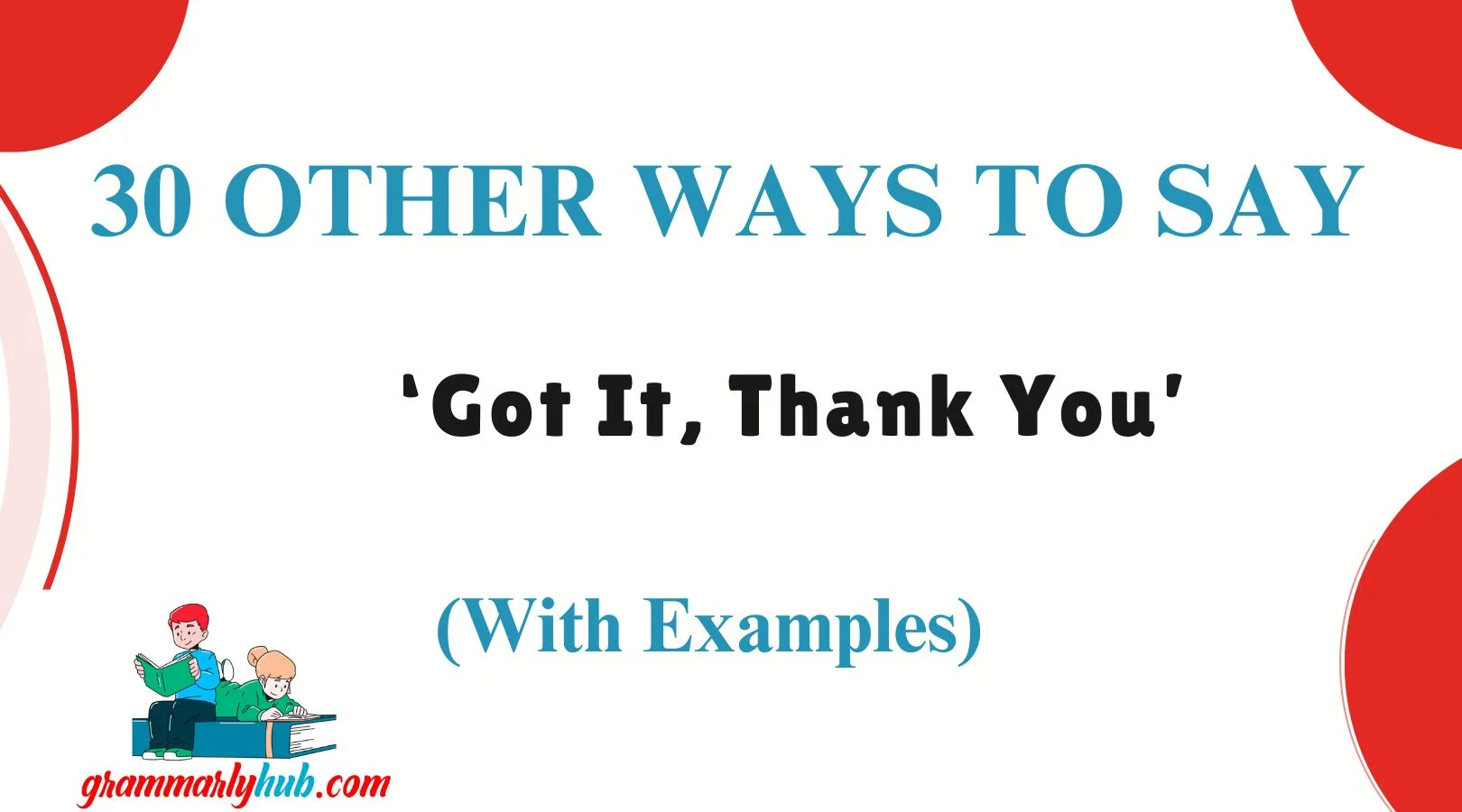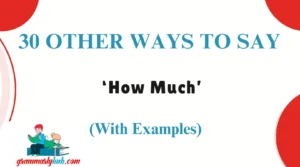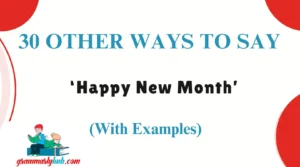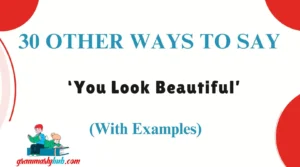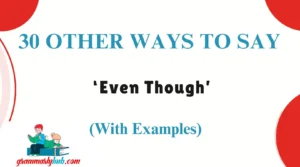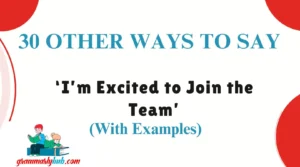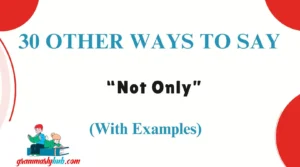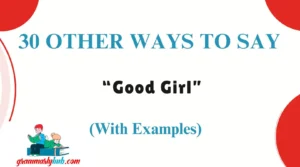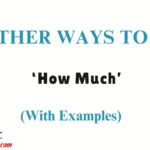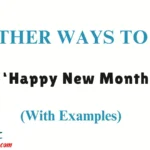Finding the right words to express appreciation and acknowledgement can make all the difference in communication. Saying “Got it, thank you” is simple and effective, but sometimes, a more thoughtful or warm alternative can help your message feel more personal and meaningful.
Whether you want to sound professional, casual, or genuinely caring, these 30 alternatives will help you communicate your gratitude and understanding with clarity and kindness. Using varied expressions can also keep your conversations fresh and show your attentiveness to others’ efforts.
What Does “Got It, Thank You” Mean?
“Got it, thank you” is a brief way to confirm understanding while expressing gratitude. It shows that you have received the information or task and appreciate the effort or help given. This phrase combines acknowledgement (“Got it”) with politeness (“Thank you”), making it a polite and clear communication tool.
When to Use “Got It, Thank You”
This phrase is great when you want to quickly confirm receipt of information or instructions while showing appreciation. It works well in emails, messages, or conversations where clarity and politeness are important. Use it when you want to acknowledge someone’s input without sounding overly formal or distant.
Is It Professional/Polite to Say “Got It, Thank You”?
Yes, “Got it, thank you” is generally professional and polite. It strikes a nice balance between being casual and courteous, suitable for workplace settings, client communications, or informal chats. However, depending on the context and relationship, you might want to choose alternatives that sound warmer or more formal.
Pros and Cons of Saying “Got It, Thank You”
Pros:
- Clear acknowledgment of information.
- Shows gratitude politely.
- Concise and easy to use in most settings.
Cons:
- May sound a bit brief or robotic in more emotional or personal contexts.
- Can feel repetitive if overused.
- Might lack warmth in sensitive conversations.
Synonyms for “Got It, Thank You”
- Noted with thanks
- Understood, thanks so much
- I appreciate it, got it
- Thanks for letting me know
- Message received, thank you
- Thanks, I’ll take care of it
- Got your message, thanks!
- Thanks, I’ll keep that in mind
- Received and appreciated
- Thank you for the update
- Thanks, I’ve got it covered
- Acknowledged with gratitude
- Thanks, I’m on it
- Thanks for the info, understood
- Appreciate it, will do
- Thanks, noted and understood
- Got that, thanks!
- Thank you, all clear now
- Thanks, I understand
- Got your point, thanks
- Thanks, I’ll act accordingly
- Appreciated, thanks for sharing
- Thanks, I’ll follow up on that
- Thanks, I’m aware now
- Thanks, I’ve taken note
- Got your email, thanks!
- Thanks, message understood
- Thanks, I’ll make sure of it
- Got it, and thanks a lot
- Thanks for the heads-up
1. Noted with Thanks
Definition: This phrase confirms that the information has been recorded or remembered, paired with gratitude.
Explanation: Use this to acknowledge information or instructions formally, often in professional emails or messages.
Scenario Example: “Noted with thanks. I will update the report accordingly.”
Worst Use: Avoid using this in casual conversations where it may sound too formal or stiff.
Tone: Formal, professional, appreciative
2. Understood, Thanks So Much
Definition: Confirms clear comprehension with added warmth by emphasizing gratitude.
Explanation: Suitable when you want to show both understanding and genuine appreciation.
Scenario Example: “Understood, thanks so much for clarifying!”
Worst Use: Not ideal for very brief or urgent replies where a faster acknowledgment is needed.
Tone: Warm, polite, appreciative
3. I Appreciate It, Got It
Definition: Expresses both gratitude and confirmation clearly.
Explanation: Combines appreciation with acknowledgment in a friendly, conversational way.
Scenario Example: “I appreciate it, got it. I’ll handle this right away.”
Worst Use: May feel redundant if used repeatedly in the same conversation.
Tone: Friendly, caring, clear
4. Thanks for Letting Me Know
Definition: Acknowledges receipt of information with thanks, focusing on the act of informing.
Explanation: Works well when someone shares new or important details with you.
Scenario Example: “Thanks for letting me know about the schedule change.”
Worst Use: Avoid in situations where you need to confirm action rather than just receipt.
Tone: Casual, polite, appreciative
5. Message Received, Thank You
Definition: A direct and clear way to confirm you’ve received information, along with gratitude.
Explanation: Common in professional contexts, signaling that the communication was successful.
Scenario Example: “Message received, thank you. I’ll proceed with the next steps.”
Worst Use: Can sound mechanical in personal conversations.
Tone: Formal, neutral, polite
6. Thanks, I’ll Take Care of It
Definition: Shows gratitude and commitment to act on the information given.
Explanation: Perfect when you want to assure the sender that you will handle the task.
Scenario Example: “Thanks, I’ll take care of it by the end of the day.”
Worst Use: Not suitable if you cannot immediately act on the task.
Tone: Responsible, polite, reassuring
7. Got Your Message, Thanks!
Definition: Casual acknowledgment of receiving a message with gratitude.
Explanation: Friendly and informal, ideal for colleagues or friends.
Scenario Example: “Got your message, thanks! I’ll get back to you soon.”
Worst Use: Avoid formal or high-stakes professional emails.
Tone: Casual, friendly, warm
8. Thanks, I’ll Keep That in Mind
Definition: Expresses thanks while indicating you will remember the information.
Explanation: Useful when the information is advisory or future-oriented.
Scenario Example: “Thanks, I’ll keep that in mind for the next meeting.”
Worst Use: Can seem passive if action is expected immediately.
Tone: Polite, thoughtful, calm
9. Received and Appreciated
Definition: Confirms receipt and expresses appreciation succinctly.
Explanation: Formal yet warm, often used in business emails.
Scenario Example: “Received and appreciated. I’ll update you shortly.”
Worst Use: Might be too formal for casual chats.
Tone: Formal, polite, appreciative
10. Thank You for the Update
Definition: Shows gratitude for new or ongoing information.
Explanation: Best when the information changes or updates an existing understanding.
Scenario Example: “Thank you for the update on the project timeline.”
Worst Use: Not fitting when confirming understanding rather than receiving updates.
Tone: Polite, professional, courteous
11. Thanks, I’ve Got It Covered
Definition: Expresses thanks and assures that the task or issue is managed.
Explanation: Useful to reassure colleagues or clients.
Scenario Example: “Thanks, I’ve got it covered for the presentation.”
Worst Use: Avoid if you are unsure about handling the task.
Tone: Confident, friendly, appreciative
12. Acknowledged with Gratitude
Definition: Formal way to confirm receipt with appreciation.
Explanation: Suitable for official or formal communications.
Scenario Example: “Acknowledged with gratitude. I will comply as instructed.”
Worst Use: Can be overly formal in casual contexts.
Tone: Formal, respectful, appreciative
13. Thanks, I’m On It
Definition: Friendly way to thank and confirm immediate action.
Explanation: Good for prompt responses and quick follow-ups.
Scenario Example: “Thanks, I’m on it and will update you soon.”
Worst Use: Avoid if the task requires more time or thought.
Tone: Casual, proactive, warm
14. Thanks for the Info, Understood
Definition: Acknowledges receipt of information and confirms understanding.
Explanation: Appropriate for both formal and informal communication.
Scenario Example: “Thanks for the info, understood. I’ll adjust accordingly.”
Worst Use: Not suitable if more clarification is needed.
Tone: Polite, clear, respectful
15. Appreciate It, Will Do
Definition: Expresses gratitude and commitment to act.
Explanation: Simple and effective for informal or workplace chats.
Scenario Example: “Appreciate it, will do by tomorrow.”
Worst Use: May sound too brief in formal emails.
Tone: Friendly, casual, responsive
16. Thanks, Noted and Understood
Definition: Confirms the information is recorded and clear.
Explanation: Common in professional settings to show attentiveness.
Scenario Example: “Thanks, noted and understood. I’ll proceed as discussed.”
Worst Use: Avoid in personal chats where it may sound robotic.
Tone: Formal, polite, attentive
17. Got That, Thanks!
Definition: Casual, quick acknowledgment with thanks.
Explanation: Great for informal communication or quick confirmations.
Scenario Example: “Got that, thanks! I’ll handle it.”
Worst Use: Not ideal for formal emails or serious topics.
Tone: Casual, friendly, warm
18. Thank You, All Clear Now
Definition: Shows gratitude and confirms understanding.
Explanation: Useful when information clears confusion or doubts.
Scenario Example: “Thank you, all clear now. I appreciate your help.”
Worst Use: Not appropriate if there is still uncertainty.
Tone: Polite, grateful, clear
19. Thanks, I Understand
Definition: Confirms comprehension and thanks.
Explanation: Good for straightforward acknowledgment.
Scenario Example: “Thanks, I understand what needs to be done.”
Worst Use: Can feel blunt if used without warmth.
Tone: Neutral, polite, clear
20. Got Your Point, Thanks
Definition: Acknowledges the main idea and thanks.
Explanation: Useful in discussions or meetings.
Scenario Example: “Got your point, thanks for explaining.”
Worst Use: Not suitable for confirming detailed instructions.
Tone: Casual, polite, conversational
21. Thanks, I’ll Act Accordingly
Definition: Expresses thanks and intention to follow instructions.
Explanation: Appropriate for professional or formal settings.
Scenario Example: “Thanks, I’ll act accordingly based on your feedback.”
Worst Use: Avoid if immediate action isn’t possible.
Tone: Formal, respectful, responsible
22. Appreciated, Thanks for Sharing
Definition: Thanks to the sender for the information shared.
Explanation: Good for informal and semi-formal contexts.
Scenario Example: “Appreciated, thanks for sharing those insights.”
Worst Use: Not fitting if a response or action is required.
Tone: Friendly, polite, warm
23. Thanks, I’ll Follow Up on That
Definition: Thanks and promises to pursue the matter further.
Explanation: Shows responsibility and gratitude.
Scenario Example: “Thanks, I’ll follow up on that with the team.”
Worst Use: Not ideal if no follow-up is planned.
Tone: Professional, warm, proactive
24. Thanks, I’m Aware Now
Definition: Confirms awareness with thanks.
Explanation: Used when information is new and important.
Scenario Example: “Thanks, I’m aware now and will update accordingly.”
Worst Use: Can sound passive if no further action is taken.
Tone: Neutral, polite, clear
25. Thanks, I’ve Taken Note
Definition: Confirms recording the information and expresses gratitude.
Explanation: Suitable for formal emails or meetings.
Scenario Example: “Thanks, I’ve taken note of your concerns.”
Worst Use: Avoid if more active response is expected.
Tone: Formal, respectful, attentive
26. Got Your Email, Thanks!
Definition: Casual acknowledgment of an email with thanks.
Explanation: Common in informal workplace communication.
Scenario Example: “Got your email, thanks! I’ll reply soon.”
Worst Use: Not suitable for formal correspondence.
Tone: Friendly, casual, warm
27. Thanks, Message Understood
Definition: Confirms understanding and thanks.
Explanation: Useful in professional and casual communication.
Scenario Example: “Thanks, message understood. I’ll proceed accordingly.”
Worst Use: May sound abrupt without additional warmth.
Tone: Polite, neutral, clear
28. Thanks, I’ll Make Sure of It
Definition: Shows thanks and commitment to ensure something happens.
Explanation: Great when you want to assure responsibility.
Scenario Example: “Thanks, I’ll make sure of it before the deadline.”
Worst Use: Avoid if you cannot guarantee the outcome.
Tone: Responsible, polite, warm
29. Got It, and Thanks a Lot
Definition: Casual acknowledgment paired with warm thanks.
Explanation: Friendly and heartfelt way to confirm.
Scenario Example: “Got it, and thanks a lot for your help!”
Worst Use: Too informal for some professional contexts.
Tone: Warm, friendly, appreciative
30. Thanks for the Heads-Up
Definition: Thanks someone for warning or informing in advance.
Explanation: Useful when information helps you prepare.
Scenario Example: “Thanks for the heads-up about the meeting time change.”
Worst Use: Not fitting when no prior warning is given.
Tone: Casual, polite, grateful
Conclusion
Saying “Got it, thank you” is a simple way to confirm understanding and show appreciation, but having a variety of alternatives can add warmth, clarity, and professionalism to your communication. Whether you want to sound formal, friendly, or genuinely caring, these phrases help you express acknowledgment with thoughtfulness. Choosing the right expression depends on your relationship with the recipient, the context, and the tone you want to convey. Use these options to enhance your messages, making them feel more personal, clear, and respectful.
FAQ
1. What is the best professional way to say “Got it, thank you”?
The most professional alternatives include “Understood, thank you”, “Acknowledged, thank you”, or “Noted with thanks”. These phrases sound respectful and clear, especially in workplace communication. They show you’ve received the message while maintaining a polite, courteous tone.
2. Is it okay to say “Got it, thank you” in formal emails?
Yes, but it depends on the context. “Got it, thank you” is polite but slightly informal. For formal emails, especially with clients, executives, or during professional negotiations, consider using alternatives like “Acknowledged, thank you” or “Message received and appreciated” for a more polished tone.
3. Can I use these alternatives in customer service or support emails?
Absolutely. Customer service communication thrives on clarity and warmth. Using phrases like “Thanks, I understand now” or “All clear, thank you” helps make your message sound human, engaged, and helpful—exactly what customers appreciate in support exchanges.
4. Are there cultural differences in how “Got it, thank you” is perceived?
Yes, slightly. In some cultures or formal settings, “Got it” might seem too casual. That’s why alternatives like “I’ve received the information, thank you” or “Understood with thanks” offer the same meaning with more sensitivity and respect—making them universally appropriate.
5: How can I respond with empathy instead of just saying “Got it, thank you”?
To add empathy, use responses like “Thanks so much, I understand now” or “Appreciate your help—I’m all set”. These phrases go beyond acknowledgment and show appreciation for the effort someone made to explain, guide, or assist you.

Welcome to GrammarlyHub, your go-to destination for mastering grammar, improving your writing, and finding the best language tools available online. Founded by Emma Rose, a passionate writer and advocate for clear communication, GrammarlyHub was built to help people express themselves with confidence and accuracy.
